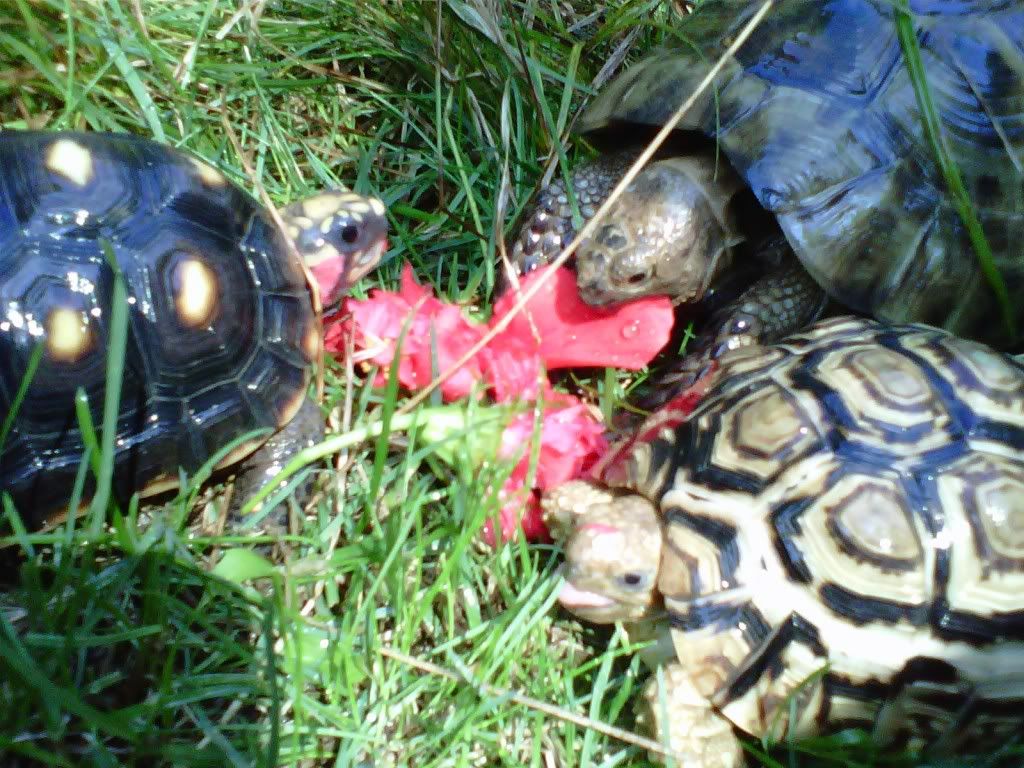- Joined
- Mar 19, 2009
- Messages
- 1,601
But they DO like pizza!
Tom said:Yep! They can swim just fine. She seemed very relaxed, not frantic as I expected. She'd look in the direction she wanted to go and just calmly paddle over there. She stopped paddling and just sat still a few times. I only let her swim for about 45 seconds, but she seemed like she would have been just fine for longer. Come to think of it my Emu did this same thing to me. They can swim like a duck. A really big duck.

emysemys said:chadk said:So the water soaking thing is interesting... I'm wondering if these carrot soaks for box turtles and torts really does anything. Anyone have any proof one way or the other? Same for other types of soaks: baby food, pediolyte(sp?), viatim water, etc...
Being a turtle and tortoise rescue, I take in my share of sick and injured turtles and tortoises.
All I can say about the Gerber baby food soaks is...when I get a box turtle with swollen shut eyes that's not eating, and I soak him in the red Gerber baby foods (squash, carrots, sweet potatoes), after three days, the swollen eyes are open and the turtle is ready to eat.
This might not be empirical research, but it IS hands on experience. I don't know how it works, since its been busted that they absorb through their skin, but it works.
emysemys said:chadk said:So the water soaking thing is interesting... I'm wondering if these carrot soaks for box turtles and torts really does anything. Anyone have any proof one way or the other? Same for other types of soaks: baby food, pediolyte(sp?), viatim water, etc...
Being a turtle and tortoise rescue, I take in my share of sick and injured turtles and tortoises.
All I can say about the Gerber baby food soaks is...when I get a box turtle with swollen shut eyes that's not eating, and I soak him in the red Gerber baby foods (squash, carrots, sweet potatoes), after three days, the swollen eyes are open and the turtle is ready to eat.
This might not be empirical research, but it IS hands on experience. I don't know how it works, since its been busted that they absorb through their skin, but it works.
Let's take a look.biglove4bigtorts said:Vitamin A could very well be acting on the eyes in this case, b/c the eyes and eyelids are a permeable membrane and could be adsorbing the Vitamin A, which is acting almost like and opthalmic Vit A drop. If it were me, I'd continue to dose these guys with food that has a higher than normal amount of grated or cooked sweet potato and supplement twice a week with a vitamin supplement that has preformed Vitamin A for a couple of months to help thier recovery. Yvonee, have you ever considered looking for an eye wash that has some vit A in it to use? I am not sure that is available, but you cold probably get a vet to help you calculate a safe dosage to mix in some saline and use to flush the eyes. I guess if what you are doing works, there is no need, but maybe I at least helped with an explanation as to why this works for you.
HLogic said:Mark, don't forget the role of the pineal gland (and 'third eye') in photodetection, circadian rhythm, etc. Varying spectral components have a significant impact on seasonal, and thus, behavioral activity (e.g. hormone production related to the reproductive cycle, timing of feeding increases/decreases, brumation/hibernation, etc.).
DeanS said:Hey Mark...I do like the library so far...and I think it's only going to get better...CONGRATS! My opinion is that a CHE and the Powersun MVB (specifically) are the ONLY artificial sources a (scrub/desert-dwelling) tort would ever need during inclement weather + winter, of course! I know you feel that one lighting source can't be a 'cure-all' but the Powersun has to come close...Yes?!?!?
Madkins007 said:By the way, if you have plants in the tort habitat, they would like the additional light wavelengths that the MVB is missing.
PeanutbuttER said:Madkins007 said:By the way, if you have plants in the tort habitat, they would like the additional light wavelengths that the MVB is missing.
That could explain in part my perpetual lack of ability to grow plants on my tort table...
I second that the library is looking great. I was on it just yesterday. Great Job. Thank you.